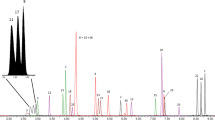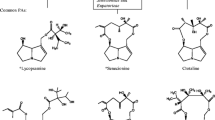Abstract
Pyrrolizidine alkaloids (PAs) are a group of plant secondary metabolites with carcinogenic and hepatotoxic properties. When PA-producing plants contaminate crops, toxins can be transferred through the food chain and cause illness in humans and animals, most notably hepatic veno-occlusive disease. Honey has been identified as a direct risk of human exposure. The European Food Safety Authority has recently identified four groups of PAs that are of particular importance for food and feed: senecionine-type, lycopsamine-type, heliotrine-type and monocrotaline-type. Liquid or gas chromatography methods are currently used to detect PAs but there are no rapid screening assays available commercially. Therefore, the aim of this study was to develop a rapid multiplex ELISA test for the representatives of three groups of alkaloids (senecionine, lycopsamine and heliotrine types) that would be used as a risk-management tool for the screening of these toxic compounds in food and feed. The method was validated for honey and feed matrices and was demonstrated to have a detection capability less than 25 μg/kg for jacobine, lycopsamine, heliotrine and senecionine. The zinc reduction step introduced to the extraction procedure allows for the additional detection of the presence of N-oxides of PAs. This first multiplex immunoassay for PA detection with N-oxide reduction can be used for the simultaneous screening of 21 samples for >12 PA analytes. Honey samples (n = 146) from various origins were analysed for PA determination. Six samples were determined to contain measurable PAs >25 μg/kg by ELISA which correlated to >10 μg/kg by LC-MS/MS.





Similar content being viewed by others
References
Stegelmeier BL, Edgar JA, Colegate SM, Gardber DR, Schoch TK, Coulombe RA, Molyneux RJ (1999) Pyrrolizidine alkaloid plants metabolism and toxicity. J Nat Toxins 8:95–116
Roeder E (1999) Analysis of pyrrolizidine alkaloids. Curr Org Chem 3:557–576
Prakash AS, Pereira TN, Reilly PE, Seawright AA (1999) Pyrrolizidine alkaloids in human diet. Mutat Res 443:53–67
Smith LW, Culvenor CCJ (1981) Plant sources of hepatotoxic pyrrolizidine alkaloids. J Nat Prod 44(2):129–152
Edgar JA, Colegate SM, Boppre M, Molyneux RJ (2011) Pyrrolizidine alkaloids in food: a spectrum of potential health consequences. Food Addit Contam A 28:308–324
Wiedenfeld H (2011) Plants containing pyrrolizidine alkaloids: toxicity and problems. Food Addit Contam A 28:282–292
Wiedenfeld H, Roeder E, Bourauel T, Edgar J (2008) Pyrrolizidine Alkaloids: Structure and Toxicity. Bonn University Press.
Boppré M (2011) The ecological context of pyrrolizidine alkaloids in food, feed and forage: an overview. Food Addit Contam 28:260–281
Fu PP, Xia Q, Chou MW, Lin GE (2007) Detection, hepatotoxicity and tumorigenicity of pyrrolizidine alkaloids in Chinese herbal plants and herbal dietary supplements. J Food Drug Anal 15:400–415
Li SL, Lin G, Fu PP, Chan CL, Li M, Jiang ZH, Zhao ZZ (2008) Identification of five hepatotoxic pyrrolizidine alkaloids in a commonly used traditional Chinese medicinal herb, Herba Senecionis scandentis (Qianliguang). Rapid Commun Mass Sp 22:591–602
Avula B, Wang YH, Wang M, Smillie TJ, Khan IA (2010) Simultaneous determination of sesquiterpenes and pyrrolizidine alkaloids from the rhizomes of Petasites hybridus (L.) G.M. et Sch. and Dietary Supplements using UPLCUV and HPLC-TOF-MS methods, Journal of Pharmaceutical and Biomedical Analysis (2012), doi:10.1016/j.jpba.2012.05.021
Kempf M, Wittig M, Schönfeld K, Cramer L, Schreier P, Beuerle T (2011) Pyrrolizidine alkaloids in food: downstream contamination in the food chain caused by honey and pollen. Food Addit Contam A 28:325–331
Kempf M, Wittig M, Reinhard A, von der Ohe K, Blacquière T, Raezke K-P, Schreier P, Beuerle T (2011) Pyrrolizidine alkaloids in honey: comparison of analytical methods. Food Addit Contam A 28:332–347
Edgar JA, Roeder E, Molyneux RJ (2002) Honey from plants containing pyrrolizidine alkaloids: a potential threat to health. J Agric Food Chem 50:2719–2730
Dübecke A, Beckh G, Lüllmann C (2011) Pyrrolizidine alkaloids in honey and bee pollen. Food Addit Contam A 28:348–358
Cao Y, Colegate SM, Edgar JA (2012) Persistence of echimidine, a hepatotoxic pyrrolizidine alkaloid, from honey into mead. J Food Compos Anal. doi:10.1016/j.jfca.2012.11.005
Griffin CT, Danaher M, Elliott CT, Kennedy DG, Furey A (2013) Detection of pyrrolizidine alkaloids in commercial honey using liquid chromatography-ion trap mass spectrometry. Food Chem 136:1577–1583
FAO/WHO (Food and Agriculture Organization/World Health Organization)(2011) Discussion paper on pyrrolizidine alkaloids. Joint FAO/WHO Food Standards Programme, CODEX Committee on Contaminants in Foods, 5th Session, the Hague, the Netherlands, 21–25 March 2011. Available via ftp://ftp.fao.org/codex/meetings/CCCF/CCCF5/cf05_14e.pdf Accessed 10 Dec 2012.
Scientific opinion on pyrrolizidine alkaloids in food and feed (2011) The European Food Safety Authority (EFSA) Journal, 9: 2406
European Commission (2008) Commission Decision 2008/558/EC of 27 June 2008 authorising the placing on the market of refined echium oil as novel food ingredient under Regulation (EC) No 258/97 of the European Parliament and of the Council. Off J Eur Union L180:17–19
Bundesinstitut für Risikobewertung (2011) Analytik und Toxizität von Pyrrolizidinalkaloiden sowie eine Einschätzung des gesundheitlichen Risikos durch deren Vorkommen in Honig. Stellungnahme Nr. 038/2011 des BfR vom 11 August 2011. Available via http://www.bfr.bund.de/cm/343/analytik-und-toxizitaet-von-pyrrolizidinalkaloiden.pdf Accessed 10 Dec 2012.
Corporative author: Ministry of Public Health, Welfare and Sports, the Netherlands.Warenwetbesluit Kruidenpreparaten Besluit van 19 januari 2001 (2001), houdende vaststelling van het Warenwetbesluit Kruidenpreparaten. Available via http://wetten.overheid.nl/BWBR0012174/geldigheidsdatum_12-01-2013#Opschrift. Accessed 10 Dec 2012.
Committee on Toxicity (COT) 2008 Committee on toxicity of chemicals in food, consumer products and the environment. COT statement on pyrrolizidine alkaloids in food. Available via http://cot.food.gov.uk/pdfs/cotstatementpa200806.pdf, Accessed July 2013.
Herber T, Lahrssen-Wiederholt M, Schafft H, Abraham K, Pzyrembel H, Henning KJ, Schauzu M, Braeunig J, Goetz M, Niemann L, Gundert-Remy U, Luch A, Appel B, Banasiak U, Boi GF, Lampen A, Wittkowski R, Hensel (2007) Zero tolerances in food and animals feed—are there any scientific alternatives? A European point of view on an international controversy. Toxicol Lett 175:118–135
Zhou Y, Li N, Choi FF-K, Qiao C-F, Song J-Z, Li S-L, Liu X, Cai Z-W, Fu PP, Lin G, Xu H-X (2010) A new approach for simultaneous screening and quantification of toxic pyrrolizidine alkaloids in some potential pyrrolizidine alkaloid-containing plants by using ultra performance liquid chromatography-tandem quadrupole mass spectrometry. Anal Chim Acta 681:33–40
Bober MA, Milco LA, Miler B, Mount M, Wicks B, Kurth MJ (1989) A competitive enzyme-linked immunosorbent assay (ELISA) to detect retronecine and monocrotaline in vitro. Toxicon 27:1059–1064
Bober MA, Kurth MJ, Milco LA, Roseman DM, Miller B, Segal HJ (1991) Chapter 16: A pyrrolizidine alkaloids enzyme-linked immunosorbent assay detection strategy. In: Immunoassays or trace Chemical Analysis, ACS Symposium Series 451:176–183.
Zündorf I, Wiedenfeld H, Röder E, Dingermann T (1997) Generation and characterization of monoclonal antibodies against the pyrrolizidine alkaloid retrorsine. Planta Med 64:259–263
Roeder E, Pflueger T (1995) Analysis of pyrrolizidine alkaloids: a competitive enzyme-linked immunoassay (ELISA) for the quantitative determination of some toxic pyrrolizidine alkaloids. Nat Toxins 3:305–309
Roseman DM, LA Wu M, Bober M, Miller RB, Kurth MJ (1992) Development of a class-specific competitive enzyme-linked immunosorbent assay for the detection of pyrrolizidine alkaloids in vitro. J Agric Food Chem 40:1008–1014
Roseman DM, Wu X, Kurth MJ (1996) Enzyme-linked immunosorbent assay detection of pyrrolizidine alkaloids: immunogens based on quaternary pyrrolizidinium salts. Bioconjug Chem 7:187–195
Langer T, Mostl E, Chizzola R, Gutleb R (1996) A competitive enzyme immunoassay for the pyrrolizidine alkaloids of the senecionine type. Planta Med 62:267–271
Cavallaro V, Than KA, Colegate SM, Edgar J. 2004 An indirect competitive ELISA for pyrrolizidine alkaloids of Heliotropium europaeum. In: Acamovic T, Stewart CS, Pennycott TW (Eds) Chapter 17 Posionous Plants and related Toxins, CAB International, Wallingford, UK.
Lee ST, Schoch TK, Stegelmeier BL, Gardner DR, Than KA, Molyneux RJ (2001) Development of enzyme-linked immunosorbent assays for the hepatotoxic alkaloids riddelliine and riddelliine N-oxide. J Agric Food Chem 49:4144–4151
Than KA, Stevens V, Knill A, Gallagher PF, Gaul KL, Edgar JA, Colegate SM (2005) Plant-associated toxins in animal feed: screening and confirmation assay development. Anim Feed Sci Technol 121:5–21
Rebe Raz S, Haasnoot W (2011) Multiplex bioanalytical methods for food and environmental monitoring. Trends Anal Chem 30(9):1526–1537
Blais BW, Gaudreault M, Phillippe LM (2003) Multiplex enzyme immunoassay system for the simultaneous detection of multiple allergens in foods. Food Control 14(1):43–47
Bienenmann-Ploum, Huet AC, Campbell K, Fodey TL, Vincent U, Haasnoot W, Delahaut P, Elliott CT, Nielen MWF (2012) Development of a five-plex flow cytometric immunoassay for the simultaneous detection of six coccidiostats in feed and eggs. Anal Bioanal Chem 404(5):1361–1373
Charlermroj R, Himananto O, Seepiban C, Kumpoosiri M, Warin N, Oplatowska M, Gajanandana O, Grant I, Karoonuthaisiri N, Elliott C (2013) Multiplex detection of plant pathogens using a microsphere immunoassay technology. PLoS One 8(4):e62344
Kloth K, Rye-Johnsen M, Didier A, Dietrich R, Martlbauer E, Niessner R, Seidel M (2009) A regenerable immunochip for the rapid determination of 13 different antibiotics in raw milk. Analyst 134:1433–1439
Fraga M, Vilariño N, Louzao MC, Rodriguez P, Campbell K, Elliott CT, Botana LM (2013) Multi-detection of paralytic. Diarrheic and amnesic shellfish toxins by an inhibition immunoassay using a microsphere-flow cytometry system. Anal Chem. doi:10.1021/ac401146m
Lattanzio VMT, Nivarlet N, Lipppolis V, Gatta SD, Huet AC, Delahaut P, Granier B, Visconti A (2012) Multiplex dipstick immunoassay for semi-quantitative determination of Fusarium mycotoxins in cereals. Anal Chim Acta 718:99–108
European Commission Decision (EC) No 2002/657/EC implementing Council Directive 96/23/EC concerning the performance of analytical methods and the interpretation of results Official Journal of the European Communities, L221, 8–34.
Mattocks AR (1986) Chemistry and toxicology of pyrrolizidine alkaloids. Academic, London (UK)
Campbell K, Stewart L, Doucette GJ, Fodey T, Haughey S, Vilarino N, Kawatsu K, Elliott C (2007) Assessment of specific binding proteins suitable for the detection of paralytic shellfish poisons using optical biosensor technology. Anal Chem 79(15):5906–5914
Xu Z-L, Deng H, Lei H-T, Jiang Y-M, Campbell K, Shen Y-D, Yang J-Y, Wang H, Sun Y-M (2012) Development of a broad-specificity monoclonal antibody-based immunoaffinity chromatography cleanup for organophosphorus pesticide determination in environmental samples. J Agric Food Chem 60(23):5847–5852
Desmet C, Blum LJ, Marquette CA (2012) High-throughput multiplexed competitive immunoassay for pollutants sensing in water. Anal Chem 84:10267–10276
Acknowledgments
The authors would like to thank the CONffIDENCE coordinator Dr. Jacob de Jong from RIKILT-Institute of Food Safety (Wageningen, the Netherlands) for his support of this research. The authors also want to acknowledge the support of Ir. Albert Swinkels from MasterLab B.V. a Nutreco company (Boxmeer, The Netherlands) CONffIDENCE partner, who provided the blank feed and honey, Dr Simon Haughey for feed samples and the many collaborators to Queen’s University who provided honey samples. CONffIDENCE is the acronym of the EU FP7 project “CONtaminants in Food and Feed: Inexpensive Detection for Control of Exposure” financially supported by the European Commission (grant agreement number 211326—collaborative project).
Author information
Authors and Affiliations
Corresponding author
Additional information
Published in the topical collection Rapid Detection in Food and Feed with guest editors Rudolf Krska and Michel Nielen.
Electronic supplementary material
Below is the link to the electronic supplementary material.
ESM 1
(PDF 302 kb)
Rights and permissions
About this article
Cite this article
Oplatowska, M., Elliott, C.T., Huet, AC. et al. Development and validation of a rapid multiplex ELISA for pyrrolizidine alkaloids and their N-oxides in honey and feed. Anal Bioanal Chem 406, 757–770 (2014). https://doi.org/10.1007/s00216-013-7488-7
Received:
Revised:
Accepted:
Published:
Issue Date:
DOI: https://doi.org/10.1007/s00216-013-7488-7




